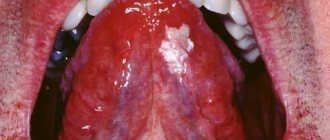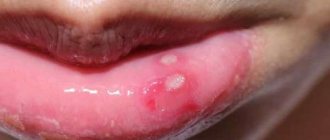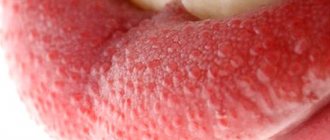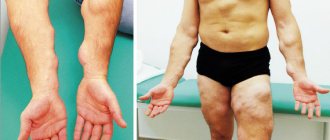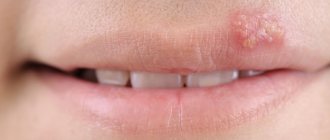Many people ask a completely logical question when they find blue veins under the tongue: what can this mean and does it indicate the development of any disease? We hasten to reassure you that in most cases this phenomenon is considered absolutely normal, due to the peculiarities of blood circulation, vessels located close to the surface and a number of other factors caused by physiological processes.
However, some diseases and borderline conditions can provoke the appearance of blue veins under the tongue, so it is important to learn to distinguish normality from pathology.
We will tell you how to do this further.
Anatomical structure of the tongue
To better understand the reasons for the appearance of blue veins, one should turn to the anatomical features of the structure and functioning of the human tongue.
It is a muscular organ covered with a mucous membrane. The tongue has many nerve endings, thanks to which the necessary signals are sent to the central nervous system.
The tongue consists of two main parts - the body, which can be easily seen with the help of a mirror, and the root, located near the pharynx. They are separated from each other by a V-shaped terminal groove. The surface of the body is rough due to the presence of multiple papillae on it, which are responsible for taste, temperature and pain perception.
In the middle of the lower part of the organ, the mucous membrane forms a frenulum , which connects it to the mucous membrane of the oral cavity. On the sides there are fringed folds, converging to the tip. It is between them and the frenulum that the elements of the circulatory system are visible.
The lingual artery is responsible for the blood supply to the lingual tissues; with its help, oxygen-enriched blood is supplied to the organ. This is how the tongue is nourished. Venous outflow is provided by a complex of lingual vessels connecting to the internal jugular vein. It is the change in their color that most often causes concern among people.
How and why we become infected with HPV:
- In most cases, HPV is transmitted through sexual contact.
- Infection is possible through household means, through touch, while staying in public places, such as baths, saunas, swimming pools, toilets or gyms.
- Self-infection, such as when you accidentally cut yourself while shaving.
- There are known cases of infection of a newborn during passage through the birth canal.
The danger of HPV lies in the fact that, once it enters the human body, it can remain in an inactive state for a long time, but then suddenly (during stress, a cold or other immune system failure) make itself felt in the form of the appearance of tumors on the body and growths on the tongue.
Why do blue veins appear under the tongue?
Since ancient times, changes in structure, color, and the formation of plaque on the surface of the tongue have been considered evidence of disturbances in the functioning of internal organs . That is, it acted as a kind of identifier of a person’s health status.
Bluish vessels, as already noted, are not always a pathological sign, but in some cases they, like a litmus test, make it possible to promptly suspect any disorders in individual organs and systems.
If the appearance of the sublingual vascular pattern changes, you should consult a doctor who will give an expert assessment of what is happening.
It’s worth noting right away that the presence of any disease is not limited to just increased coloration of the tongue; it should be considered, rather, as an additional sign. Let's consider a number of reasons that provoke such a clinical manifestation.
Nutrient deficiency
A lack of B vitamins can affect the appearance of not only blood vessels, but the entire oral cavity. In particular, when there is insufficient intake of vitamin B2, known as riboflavin, similar symptoms appear in the body.
In addition, a person becomes susceptible to a number of diseases of the oral cavity and throat, such as stomatitis, pharyngitis, tonsillitis , he regularly develops cracks on his lips that do not heal for a long time, the color of the tongue surface also changes, darkens and acquires a purple tint.
This condition is corrected by additional intake of vitamins in tablet form and selection of an appropriate diet.
Respiratory diseases
Insufficient saturation of the circulatory system with oxygen due to various pathologies of the respiratory system leads to increased coloration of the lingual vessels , even black. For any of the diseases of the lungs and bronchi, the main symptoms are characterized by lack of air, coughing with or without sputum, and the presence of wheezing, which can be heard when listening to the chest with a phonendoscope.
High cholesterol
Disturbed lipid metabolism and the appearance of fatty plaques significantly disrupt the natural blood flow and nutrition of organs. For this reason, the sublingual space may have an excessively dark color.
Circulatory disorders
In most cases, it is problems with the circulatory system that provoke visual darkening of the vascular pattern. In particular, varicose veins in the sublingual area can appear as a result of:
- increased intravascular pressure as a result of heart failure due to atrial fibrillation and flutter and valve defects;
- hereditary predisposition, characterized by some thinning of individual walls, as a result of which nodes and bloating appear;
- hemorrhoids - a pathological condition accompanied by a violation of the outflow of blood with the formation of nodes localized in the rectal area. You can learn more about varicose veins of the rectum from our article;
- decrease in the elasticity of vascular walls due to age-related changes.
Painful sensations
Swollen blue veins that appear under the tongue indicate the development of varicose veins. Due to anatomical features, the vessels themselves cannot hurt due to the absence of nerves in them.
Due to the course of varicose veins , they expand and put pressure on the nerve endings located in the immediate vicinity, causing pain in the sublingual area. It is these sensations that non-medically savvy people confuse with pain in the vessel.
In addition, late stages of the development of the disease provoke violations of the integrity of the integument due to the formation of ulcers, which will definitely cause discomfort.
promptly seeking qualified help , you can get complications from varicose veins in the form of thrombophlebitis. Blockage of the lumen of the sublingual vessel by a thrombus will inevitably make itself felt not only by visual changes, but also by physical pain.
If, during dental surgery, when a tooth was pulled out, blue veins with characteristic swelling were noticed under the tongue, you should consult the doctor who performed the extraction. He will be able to examine the picture in detail, draw appropriate conclusions and, if necessary, refer you to a specialized specialist.
Read more about massage for varicose veins in our material.
What is the danger of developing growths on the tongue?
Often a person does not even suspect that HPV is present in his body, which manifests itself in the form of papillomas. If the growth is localized on the inside of the tongue, closer to the palate, then the patient may not notice the growth. And then the doctor accidentally finds the papilloma during an examination of the patient’s oral cavity.
Papillomas that are located on the tip of the tongue are less common, but they are always noticeable. Such growths interfere with talking and eating, so people with such growths most often seek help from a medical facility.
What else can you expect from a growth on the tongue, besides discomfort:
- Papilloma is a benign neoplasm that in itself does not pose a threat to human health. But in 1.2% of cases, malignancy of such processes occurs, i.e. The tumor goes from benign to malignant.
- The oral cavity is an extremely undesirable place for papillomas to be found. If in other parts of the body growths can “live” quietly, and the doctor will not recommend removing a tumor that does not pose a threat, then papillomas on the tongue are often injured. This can lead to inflammation.
How to diagnose
If you suspect the development of varicose veins, the only correct decision would be to consult a specialized doctor - a phlebologist. He will conduct a visual examination and collect anamnesis, after which he will prescribe additional studies to obtain comprehensive information on a particular case.
Ultrasound examination of the affected areas is an accessible and informative method of diagnosis for varicose veins. With its help, qualitative indicators of blood outflow are checked , allowing one to determine the presence or absence of blood clots that pose a real threat to health. Sometimes radiography is prescribed using a special contrast agent.
Despite the fact that women are more susceptible to developing varicose veins, its manifestations in the sublingual area occur equally often in both sexes.
We wrote in detail about the methods of diagnosis and treatment of varicocele on the left testicle in our article.
How to treat
Modern methods of treating varicose veins can be divided into medicinal and surgical. The former are used to slow down and stop the course of the disease in the initial stages, from initial manifestations to stage 2 disease.
Surgery is a panacea for advanced disease. However, it is the latter that has the most pronounced result and allows you to get rid of not only the cosmetic problem, but also the possible development of complications caused by this pathology.
The choice of the necessary treatment method is the prerogative of the attending physician alone, who can correctly assess the patient’s condition.
Conservative therapy involves taking medications with various pharmacological effects, namely venotonics, anticoagulants, antiplatelet drugs . Some of them come in various forms and are used both internally and topically.
Blue swollen veins that appear under the tongue, photos of which can often be seen on the Internet, can be treated surgically or by injecting a sclerosing substance into the venous cavity, causing it to stick together.
Veins are removed by microphlebectomy or laser coagulation. Any of these techniques is aimed at restoring proper blood circulation. We described in our material how varicocele manifests itself and is treated in adolescents.
Features of child treatment
The treatment strategy for growths under the tongue in children includes two main stages: improving the immune system and eliminating formations in the mouth.
There are difficulties in selecting agents for local action on papillomas due to the constant contact of the drug with saliva. Therefore, the first recommendation for children is to change their usual toothpaste to a professional product that has a bactericidal effect.
When choosing antiviral drugs, the priority is not effectiveness, but safety. The ideal option is a drug that contains a combination of ascorbic and rutic acids (for example, Ascorutin). Recommended immunomodulators include: Amiksin, Viferon.
When determining the most suitable method for removing papillomas, the accuracy and speed of the procedure, as well as the low level of risks, are taken into account.
How dangerous?
It is impossible to give a definite answer to this question due to various reasons for the manifestation of such symptoms.
If the structure of the vessel is not disturbed, but it is blue or black in color, this may be a normal variant. Venous blood is darker in color than arterial blood due to its saturation with carbon dioxide. Additional blueness is given by the vascular wall, mucous membrane and other tissues that can distort the real shade of blood.
Another situation that also does not require treatment and is considered completely natural is the aging of the body. , a natural thinning of the vascular walls occurs , resulting in dark blue veins appearing under the tongue.
A change in not only the color, but also the structure of the sublingual venous lines, the formation of nodules, multiple or single, the appearance of painful sensations - all this is a reason to contact a specialist to carry out a differential diagnosis and establish the root cause of the manifestation of such symptoms. Read more about varicocele in a 14-year-old teenager in our material.
How to get rid of papillomas?
If the growths on your tongue are present in small quantities and are small in size, then the process of removing such growths is quite simple. But this does not mean that you can remove the papilloma yourself, using such “effective folk remedies” as cauterization, cutting the “leg” of the tumor with scissors, etc. To remove the growth, you should contact a professional medical institution.
Methods for removing tumors:
- Excision of papillomas with a scalpel or electric knife. This affects not only the growth itself along with the stem, but also part of the healthy tissue around it.
- Laser removal of tumors.
- By using a tool such as a conchotome, shaped like a wire cutter. After removing the papilloma with such a device, galvanoacoustics is performed (cauterization of the localization of the growth using a platinum wire).
Do I need to follow a diet?
If any of the reasons listed above have been medically established as causing the appearance of a cosmetic defect, it would not be a bad idea to reconsider your own gastronomic preferences.
Each of these conditions requires at least a slight adjustment of the diet , especially if a person prefers to eat “junk” food. The adjustment is as follows:
- in increasing the volume of consumption of products of plant origin - vegetables, fruits, herbs in fresh, baked form, as well as in salads;
- excluding excessively fatty meat, spicy, salty and fried foods from the menu. When cooking food, you should choose baking, boiling or steaming;
- in regular consumption of sea fish and seafood, as the main source of saturated acids;
- in choosing pasta made from durum wheat or vegetables as a side dish for meat or fish dishes, depending on individual preferences;
- You can’t give up cereals; they are a source of vitamins and microelements. The most useful are buckwheat, oatmeal, and pearl barley;
- You should use olive or any other vegetable oil as a salad dressing. As an exception, it is allowed to consume homemade mayonnaise once a week for this purpose in limited quantities - no more than 30 ml.
Treatment methods at home
The basis of home therapy is following the doctor’s recommendations and maintaining a healthy lifestyle. Quitting smoking, drinking alcoholic beverages, and observing basic dietary restrictions are the main requirements in the therapy process.
If varicose veins are diagnosed in the sublingual area in the initial stages, it is advisable to use various decoctions and infusions of herbal components that have anti-inflammatory and restorative effects as additional measures. Let's look at the best recipes:
- Mix a glass of water at room temperature with a tablespoon of natural apple cider vinegar. Divide the contents into 2 doses and consume immediately after meals;
- Divide the sour apple into 6 slices, fill them with 500 ml of boiling water, leave for 4 hours. Then mash the fruits, add 3 teaspoons of honey and take the resulting liquid three times a day, 150 ml before meals;
- nutmeg-alcohol tincture has also proven itself as an effective remedy in the fight against diseases of the circulatory system. Mix 250 grams of crushed nuts with a bottle of vodka and leave for 20 days in a cool place, protected from direct sunlight. Take 20 drops half an hour before meals.
Under no circumstances should you rely on traditional medicine alone and refuse drug therapy prescribed by your doctor. This can aggravate the course of the disease and provoke complications.
If the pain is associated with damage to the frenulum
The hyoid frenulum is a mucous membrane that connects the tongue to the base of the mouth. Inflammation can be caused by:
- Diseases occurring in the oral cavity - stomatitis, gingivitis, periodontitis;
- Using incorrect hygiene products: toothpaste, toothbrush, mouthwash;
- Allergies caused by taking medications.
Inflammation of the frenulum under the tongue can also occur as a result of injury to it during brushing teeth, eating (too hot or cold foods), talking loudly, sharply biting the tongue, or careless handling of cutlery.
The reason why it hurts under the tongue may also be a physiological feature. In cases where the frenulum is short from birth, the likelihood of damage increases significantly, and discomfort can occur even while eating.
What can you do
A visit to the dentist cannot be avoided if the frenulum under the tongue hurts. The doctor will examine the damage and prescribe treatment. At home, especially if you can’t immediately visit a specialist, in order to relieve pain, you can rinse your mouth:
- Soda solution (a teaspoon per glass of chilled boiling water);
- Chamomile or sage decoction;
- Preparations: Stomatofit, Rotokan, Chorophyllipt.
Also, if the frenulum under the tongue is inflamed, it is recommended to treat the affected area with Iodinol or place a cotton swab dipped in sea buckthorn oil at the damaged area. Such measures can only be used in cases where you know for sure that the cause of the pain under the tongue is an inflamed frenulum.
Preventive actions
The following tips will help reduce the chances of pathological changes in the sublingual area:
- nutrition should be regular and balanced;
- oral hygiene measures should be carried out 2 times a day, morning and evening;
- Regular medical examinations by highly specialized doctors will allow you to identify the slightest changes at the initial stages, when they are still being successfully treated. Such events should be held at least once a year;
- if there is a hereditary predisposition to varicose veins, constant moderate physical activity should be maintained;
- Sanitation of the oral cavity at the dentist will avoid the proliferation of pathogenic microflora in it, which becomes the impetus for the formation of pathology.
As you know, it is much easier to prevent the development of a disease than to cure it later, so you should not neglect these simple rules.
How to avoid relapse of the disease?
After the growth has been removed from the patient's tongue, the person should not relax. Typically, single papillomas do not recur, but with multiple formations, the reappearance of growths on the body occurs quite often.
Therefore, after surgical removal of papillomas from the surface of the tongue, you should:
- Take precautions and limit risk factors (see above).
- Take a course of antiviral treatment as recommended by your doctor.
- Seasonally take immunomodulatory drugs and vitamin complexes, which your doctor will also help you choose.
- Maintain oral hygiene and avoid tongue injuries.
One of the main conditions for achieving a favorable outcome in the fight against papillomas is choosing the right medical center, since much in the procedure for removing a tumor depends on the actions of the doctor. We hope that the recommendations of specialists from the LeaderStom network of dental clinics helped you clarify the picture of the growth that has developed on your tongue, and now you can solve this problem without unnecessary emotional distress.


